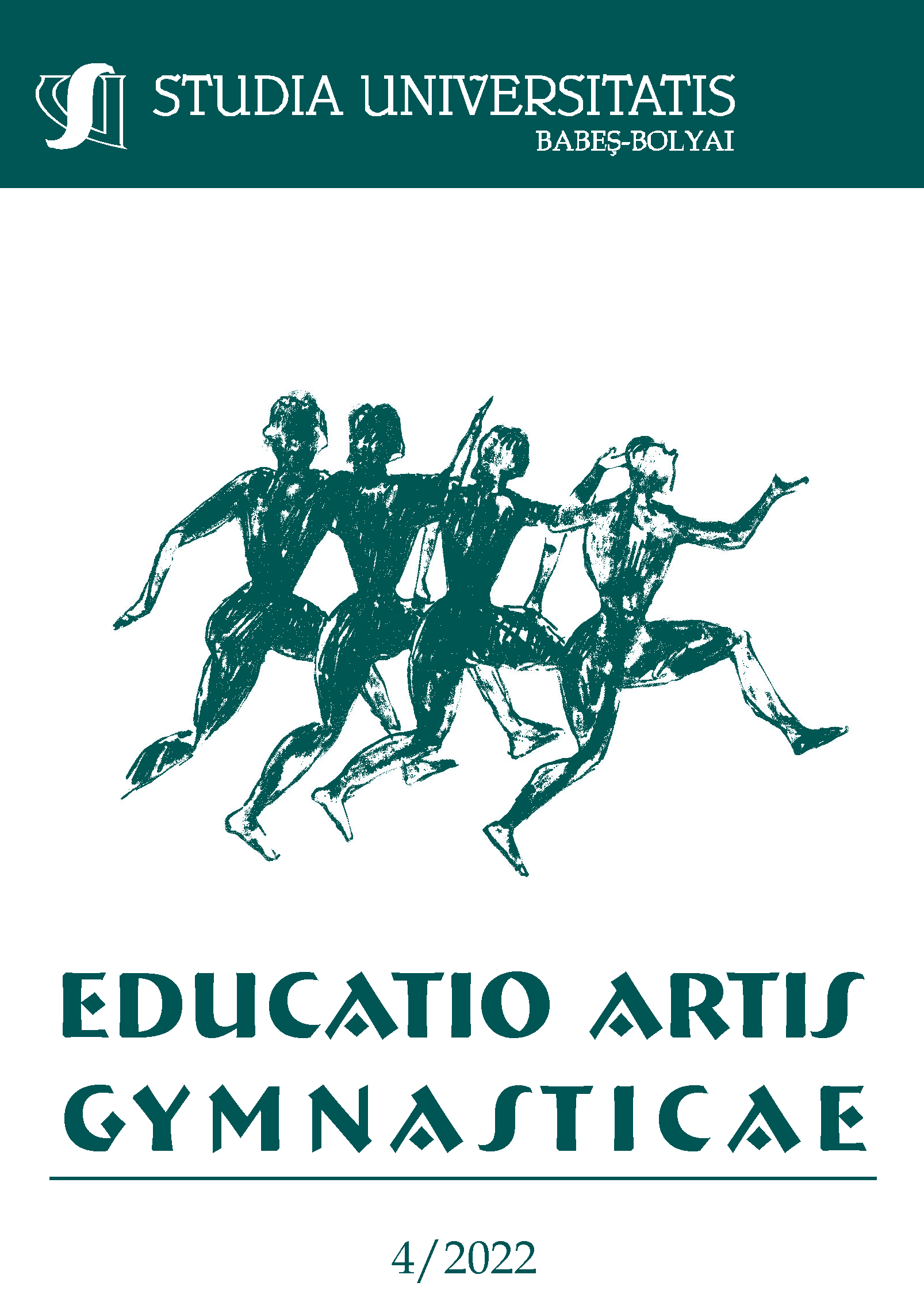KINEMATIC ANALYSIS OF HIP JOINT MODIFICATIONS IN SWITCH LEAP: COMPENSATORY MECHANISMS DUE TO REDUCED MOBILITY IN THIS AREA
DOI:
https://doi.org/10.24193/subbeag.67(4).36Keywords:
hip joint modifications, gymnastics, switch leap, compensatory mechanisms, flexibilityAbstract
Artistic gymnastics include a series of artistic elements where the joints’ mobility represents an essential factor for the accuracy of the execution in both beam and floor routines. The reduced mobility is responsible for the occurrence of compensatory movements. This type of repetitive and long-term compensations can damage the joints involved in execution of an accurate switch leap element. The aim of the study was to analyze the compensatory mechanisms due to reduced mobility in the hip joint that can occur during the execution of a switch leap. 6 female gymnasts (8-10 years) from C.S.S.1 Timisoara have been analyzed when they executed switch leap on the floor. The kinematic analysis was carried using inertial sensors for movement tracking technology. The evaluated parameters were: leg separation angle (LSA), lateral pelvic tilt (LPT) and pelvic rotation (PR). The data revealed a LSA of 137.5± 2.239° which corresponds to the second level of penalty (0.30 points). The compensatory movements were revealed by the level of LPT and pelvic rotation. Depending on the front leg, the compensatory tilt, represented by the elevation of the hip joint, was found on the right or left part accordingly. Regarding the pelvic rotation, this is performed in the backward direction on the same part with the tilt. The kinematic analysis of the switch leap element provides supplementary data that can be taken into consideration by the gymnasts and coaches during the training period in order to reduce the risk of injuries and the risk of falling from the beam.
References
Cantó, E., Sánchez, A., Sánchez, J. (2009). Test más apropiados para la valoración funcional del deportista en gimnasia rítmica. [Most appropriate test for the valuation functional of the athlete in rhythmic gymnastics]. Efdeportes Revista Digital, 13: 25–30. (In Spanish).
Decoster, L.C., Vailas, J.C., Lindsay, R.H., Williams, G.R. (1997). Prevalence and features of joint hypermobility among adolescent athletes. Archives of pediatrics & adolescent medicine, 151(10):989-92
Di Cagno, A., Baldari, C., Battaglia, C., Guidetti, L., & Piazza, M. (2008). Anthropometric characteristics evolution in elite rhythmic gymnasts. Italian Journal of Anatomy and Embryology, 113(1): 29–36.
Domokos, C., Dragomir, A., Bidiugan, R., Mirica, S. N., Domokos M., Negrea, C., Bota E., & Nagel, A. (2020). Kinematic analysis of the centre of mass variation and its influence on the backward tucked salto, accepted for publication in the Proceedings of the 6th International Conference of Universitaria Consortium “FEFSTIM: Physical Education, Sports and Kinesiotherapy – implications in quality of life”.
Domokos, C., Mirica, N., Dragomir, A., Domokos, M., Argesanu, V., Borozan, I. & Nagel, A. (2020). Kinematic quantification of knee joint asymmetry during preparatory phase of a standing backward tucked salto, Subotica, 18th International Symposium on Intelligent Systems and Informatics SISY 2020, In press, accessed 15.09.2020, https://ieeexplore.ieee.org/document/9217081
Faur, M.L. (2014). Teoria Educației Fizice și Sportului. Timișoara: Ed. Mirton, pp 30.
Fink, H., Hofmann D., & López L.O. (2021). Age Group Development and Competition Program for Women’s Artistic Gymnastics. [Internet]. Fédération Internationale De Gymnastique (FIG); 2015 [updated 2021 Apr 15; cited 2021 May 5]. Available at: http://www.fig-docs.com/website/agegroup/manuals/Agegroup-wag-manual-e.pdf.
Fink, H., & Hofmann, D. (2021). Age Group Development and Competition Program for Men’s Artistic Gymnastics. [Internet]. Fédération Internationale De Gymnastique (FIG); 2015 [updated 2021 Apr 15; cited 2021 May 5]. Available at: https://www.fgp-ginastica.pt/_usr/downloads/age_group_program_por_atual.pdf.
Grahame, R., Bird, H., & Child, A. (2000). The revised (Brighton 1998) criteria for the diagnosis of benign joint hypermobility syndrome (BJHS). The Journal of Rheumatology, 27(7):1777-9.
Hakim A, Grahame R. (2003). Joint hypermobility. Best Practice & Research Clinical Rheumatology, 17(6):989-1004.
Jeffreys, I. (2016). Essentials of Strength Training and Conditioning. In: G Gregory Haff and N Travis Triplett (Editors) Warm-Up and Flexibility Training. National Strength and Conditioning Association NSCA. Human Kinetics; p.317–350.
Larsson, L.-G., Baum, J., Mudholkar, G., Srivastava, D. (1993). Hypermobility: prevalence and features in a Swedish population. Rheumatology, 32(2):116-9.
McCormack, M., Briggs, J., Hakim, A., Grahame, R. (2004). Joint laxity and the benign joint hypermobility syndrome in student and professional ballet dancers. The Journal of Rheumatology, 31(1):173-8.
Seçkin Ü, Tur BS, Yılmaz Ö, Yağcı İ, Bodur H, Arasıl T. (2005). The prevalence of joint hypermobility among high school students. Rheumatology International, 25(4): 260-3.
Smith, R., Damodaran, A., Swaminathan, S., Campbell, R., & Barnsley, L. (2005). Hypermobility and sports injuries in junior netball players. British Journal of Sports Medicine, 39 (9):628-31.
Xsens MVN User Manual,” Xsens Technologies, (2018a), https://www.mouser.com/datasheet/2/693/xsense_08142018_MTi_User_Manual_Mk5_-_MT0605P2018-1389005.pdf, accessed 15.09.2020.
Xsens Technologies, “MVN User Manual, Revision Z.”, (2018b), https://www.xsens.com/hubfs/Downloads/usermanual/MVN_User_Manual.pdf, accessed 15.09.2020 8.
Xsens MVN Whitepaper: Consistent Tracking of Human Motion Using Inertial Sensing”, Document MV0424P.A, M. G. a. G. B. M. Schepers, “Xsens MVN Whitepaper: Consistent Tracking of Human Motion Using Inertial Sensing”, Document MV0424P.A,” 2018, accessed 15.09.2020.
Downloads
Published
How to Cite
Issue
Section
License
Copyright (c) 2022 Studia Universitatis Babeș-Bolyai Educatio Artis Gymnasticae

This work is licensed under a Creative Commons Attribution-NonCommercial-NoDerivatives 4.0 International License.






